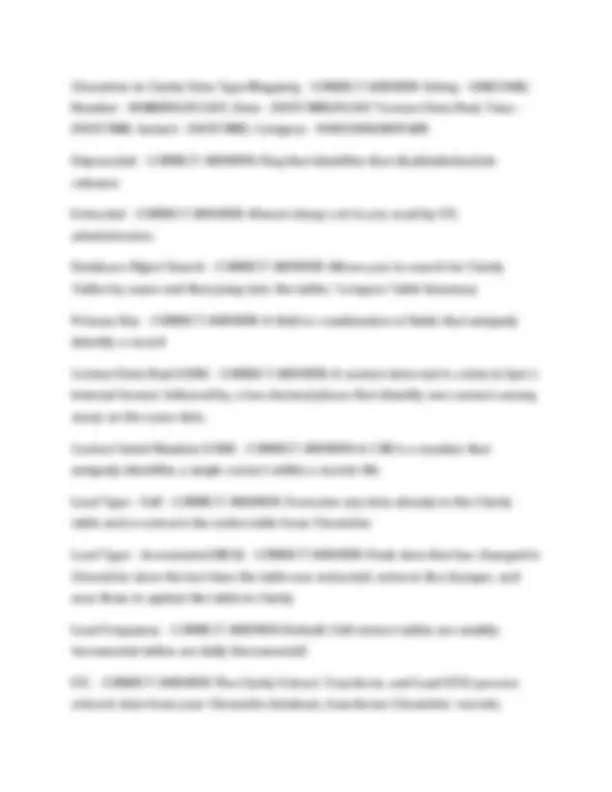








Study with the several resources on Docsity

Earn points by helping other students or get them with a premium plan


Prepare for your exams
Study with the several resources on Docsity

Earn points to download
Earn points by helping other students or get them with a premium plan
Community
Ask the community for help and clear up your study doubts
Discover the best universities in your country according to Docsity users
Free resources
Download our free guides on studying techniques, anxiety management strategies, and thesis advice from Docsity tutors
Clarity Distribution Mechanisms - CORRECT ANSWER-EPIC-Crystal Integration; Business Objects Universes; Radar (information center/Portal ) The way data is stored in EPIC - CORRECT ANSWER-Chronicles (Storage);Master File/INI (Patient Records); Record (John Accrual); Contact (6/30/2012 Admission); Item (Attending Providers); Line (First Attending, etc.)
Typology: Exams
1 / 10

This page cannot be seen from the preview
Don't miss anything!







Clarity Distribution Mechanisms - CORRECT ANSWER-EPIC-Crystal Integration; Business Objects Universes; Radar (information center/Portal ) The way data is stored in EPIC - CORRECT ANSWER-Chronicles (Storage);Master File/INI (Patient Records); Record (John Accrual); Contact (6/30/2012 Admission); Item (Attending Providers); Line (First Attending, etc.) Point of data in Chronicles can be identified by - CORRECT ANSWER-Its INI and Item Number Control Left-Click Method - CORRECT ANSWER-One method to find where the data lives though Hyperspace Raw data in Item Information - CORRECT ANSWER-System information that is probably different from what end user sees Item .1 - CORRECT ANSWER-Record ID Item .2 - CORRECT ANSWER-Record Name Chronicles Data Type - String - CORRECT ANSWER-Any combination of characters Chronicles Data Type - Number - CORRECT ANSWER-Any number - can be an integer or a decimal Chronicles Data Type - Time - CORRECT ANSWER-A time without a date; stored as the number of seconds since midnight; converted back to normal time for display
Chronicles Data Type - Instant - CORRECT ANSWER-Date/Time stored in single item as the number of seconds since midnight on 12/31/1840 and converted back to normal for display Chronicles Data Type - Category - CORRECT ANSWER-A pre-defined list of choices; Some can be modified by customers, some cannot Response Types - CORRECT ANSWER-Determines how many lines of data an Item can hold Response Types - Single Response - CORRECT ANSWER-Only one line of data can be stored Response Types - Multiple Response - CORRECT ANSWER-Multiple lines of data can be stored (e.g. addresses) Response Types - Related Groups - CORRECT ANSWER-Multiple lines of data can be stored and each one of these lines is related to a line in another item (e.g. Different Phone numbers ) Add Types - CORRECT ANSWER-Identifies whether a data changes on the item for each Contact or is stored directly on a record Add Types - No-Add - CORRECT ANSWER-Stores items directly on a record, not a specific contact Add Types - Response Each Time - CORRECT ANSWER-Stores values separately on each of a record's contact Add Types - Lookback - CORRECT ANSWER-Stores values separately on each contact, but assume that last value remains true until new value is entered (not used very often anymore.
Chronicles to Clarity Data Type Mapping - CORRECT ANSWER-String - VARCHAR; Number - NUMERIC/FLOAT; Date - DATETIME/FLOAT*Contact Date Real; Time - DATETIME; Instant - DATETIME; Category - VARCHAR/INTEGER Deprecated - CORRECT ANSWER-Flag that identifies that disabled/obsolete columns Extracted - CORRECT ANSWER-Almost always set to yes; used by ETL administrators Database Object Search - CORRECT ANSWER-Allows you to search for Clarity Tables by name and then jump into the tables' Compass Table Summary Primary Key - CORRECT ANSWER-A field or combination of fields that uniquely identify a record Contact Date Real (CDR) - CORRECT ANSWER-A contact date real is a date in Epic's internal format, followed by a two decimal places that identify one contact among many on the same date. Contact Serial Number (CSN) - CORRECT ANSWER-A CSN is a number that uniquely identifies a single contact within a master file Load Type - Full - CORRECT ANSWER-Truncates any data already in the Clarity table and re-extracts the entire table from Chronicles Load Type - Incremental (REQ) - CORRECT ANSWER-Finds data that has changed in Chronicles since the last time the table was extracted, extracts the changes, and uses them to update the table in Clarity Load Frequency - CORRECT ANSWER-Default: Full-extract tables are weekly; Incremental tables are daily (incremental) ETL - CORRECT ANSWER-The Clarity Extract, Transform, and Load (ETL) process extracts data from your Chronicles database, transforms Chronicles' records,
items, and contacts into the tables, rows, and columns of a relational database, and loads it into an Oracle, Microsoft SQL Server, or Teradata database on a dedicated reporting server. Category Tables - CORRECT ANSWER-ZC tables; Performance Tip - filter or sort on the C columns * Data Seeding - CORRECT ANSWER-Data Seeding is useful if the database you are using to validate a report doesn't have the necessary information available to spot check the data. To perform data seeding you, or the report requester, performs workflows in the system that would result in information being added to the report. Should never be performed in production environment. Report Testing Forms - CORRECT ANSWER-On UserWeb and lists measures that should be tested and validated Reporting Implementation Handbook - CORRECT ANSWER-UserWeb document that outlines process for getting reporting ready for your end users My Reports - CORRECT ANSWER-Epic > Reports > My Reports Creating a Reporting Workbench Report - CORRECT ANSWER-Reports in Reporting Workbench are made from templates. Templates control many things about a report, including what master files the query searches, what criteria are available, and many aspects of the user interface. Historical Instances of Reports in Hyperspace - CORRECT ANSWER-By default, when the system completes a new run for a given report, it deletes and replaces the old results. This method saves space and provides users with only the most up- to-date information; To enable historical instances of report, you must use Web BLOB Service (WBS) to control access. Talk to your Epic representative about setting this up. You can also
production server. They also can include complex grouping and mathematics, and can be used to do integrated reporting on Epic and non-Epic data. Why should you not use Clarity for operational reporting needs? - CORRECT ANSWER-Most importantly, Clarity data is not real-time, so any operational reports built from Clarity data will be out-of-date from the moment they're generated. They also cannot be used interactively, such as in a workflow where the report jumps a user to a patient's chart. You have a reporting need, and there is no pre-built application report to meet it. Do you need to use Clarity to meet this need? - CORRECT ANSWER-Not necessarily. Reporting Workbench can be used for many non- standard reporting needs. Would the following report be an operational or analytical report? - CORRECT ANSWER-Create a report that counts the number of logs each surgeon has been documented as performing in during the past year. Display the log ID, the name of the surgeon, and the log's primary procedure. This is an analytical report. What is the difference between a record and a contact? - CORRECT ANSWER-A record is a single entity. What kind of thing depends on the master file - a record in the patient master file is a patient, a record in the provider master file is a provider, etc. A contact represents a single moment in time for that record. What is the difference between a multiple response item and a response each time item? - CORRECT ANSWER-These refer to different item characteristics. "Multiple response" refers to a particular Response Type. A multiple response item can hold multiple answers on one contact. "Response each time" refers to a particular Add Type. A response each time item can hold different answers on different contacts.
True or False: A patient who has been seen twice at your facility should have two records in the Patient master file. - CORRECT ANSWER-False - The patient should only have one record, but that record will have two contacts. A user shows you a field in Hyperspace that they want to report on. How can you find where in Chronicles that field files to? - CORRECT ANSWER-Control left-click it. If that doesn't work, try using the Chronicles Record Viewer. If you know a Chronicles INI and item, and you want to know the Clarity column it extracts to, how can you find it? - CORRECT ANSWER-Use Column Search, and enter the INI and Item. What happens when a column is marked as Deprecated? - CORRECT ANSWER-No more data will be extracted into the column, although any data already there will not be deleted. What does it mean if a column's name ends with C? - CORRECT ANSWER-The column holds a category value. You'll need to link it to a ZC table to find what that category value means. True or False: A Clarity table with only one column listed as the primary key will always hold no-add, single-response data. - CORRECT ANSWER-False; for example, a table with a CSN listed as the primary key would hold overtime, single-response data. If you need to use two copies of ORDER_PROC, why shouldn't you give the two copies the aliases ORDER_PROC_1 and ORDER_PROC_2? - CORRECT ANSWER- Looking in the Clarity Data Dictionary, there is a table named ORDER_PROC_2. If you were to use ORDER_PROC_2 as an alias it would be difficult to determine if you are using the ORDER_PROC_2 table or if it is an alias you have assigned to the ORDER_PROC table.
True or False. In the Template Manager, users can set template-level overrides to determine after how many days a user's Epic-Crystal subscription should be inactivated - CORRECT ANSWER-True.